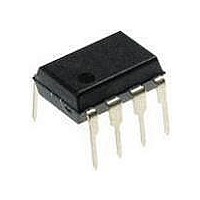PIC12F1840-I/P Microchip Technology, PIC12F1840-I/P Datasheet - Page 292

PIC12F1840-I/P
Manufacturer Part Number
PIC12F1840-I/P
Description
7 KB Flash, 256 Bytes RAM, 32 MHz Int. Osc, 6 I/0, Enhanced Mid Range Core 8 PDI
Manufacturer
Microchip Technology
Datasheet
1.PIC12F1840-IP.pdf
(382 pages)
Specifications of PIC12F1840-I/P
Processor Series
PIC12F
Core
PIC
Program Memory Type
Flash
Program Memory Size
7 KB
Data Ram Size
256 B
Interface Type
MI2C, SPI, EUSART
Number Of Timers
3
Operating Supply Voltage
1.8 V to 5.5 V
Maximum Operating Temperature
+ 85 C
Mounting Style
Through Hole
Package / Case
PDIP-8
Development Tools By Supplier
MPLAB IDE Software
Minimum Operating Temperature
- 40 C
Lead Free Status / Rohs Status
Lead free / RoHS Compliant
Available stocks
Company
Part Number
Manufacturer
Quantity
Price
Company:
Part Number:
PIC12F1840-I/P
Manufacturer:
MICROCHIP
Quantity:
200
- Current page: 292 of 382
- Download datasheet (4Mb)
PIC12(L)F1840
26.4.2
The following bits are used to configure the EUSART
for Synchronous slave operation:
• SYNC = 1
• CSRC = 0
• SREN = 0 (for transmit); SREN = 1 (for receive)
• CREN = 0 (for transmit); CREN = 1 (for receive)
• SPEN = 1
Setting the SYNC bit of the TXSTA register configures the
device for synchronous operation. Clearing the CSRC bit
of the TXSTA register configures the device as a slave.
Clearing the SREN and CREN bits of the RCSTA register
ensures that the device is in the Transmit mode,
otherwise the device will be configured to receive. Setting
the SPEN bit of the RCSTA register enables the
EUSART.
26.4.2.1
The operation of the Synchronous Master and Slave
modes
“Synchronous Master
case of the Sleep mode.
TABLE 26-9:
DS41441B-page 292
BAUDCON
INTCON
PIE1
PIR1
RCSTA
TXREG
TXSTA
Legend: — = unimplemented location, read as ‘0’. Shaded cells are not used for Synchronous Slave Transmission.
Name
*
are
Page provides register information.
SYNCHRONOUS SLAVE MODE
EUSART Synchronous Slave
Transmit
TMR1GIE
TMR1GIF
ABDOVF
CSRC
SPEN
identical
Bit 7
SUMMARY OF REGISTERS ASSOCIATED WITH SYNCHRONOUS SLAVE
TRANSMISSION
GIE
Transmission”), except in the
RCIDL
(see
PEIE
ADIE
ADIF
Bit 6
RX9
TX9
Section 26.4.1.3
TMR0IE
SREN
TXEN
RCIE
RCIF
Bit 5
—
EUSART Transmit Data Register
Preliminary
CREN
SYNC
SCKP
INTE
TXIE
Bit 4
TXIF
ADDEN
SENDB
BRG16
SSPIE
SSPIF
IOCIE
If two words are written to the TXREG and then the
SLEEP instruction is executed, the following will occur:
1.
2.
3.
4.
5.
26.4.2.2
1.
2.
3.
4.
5.
6.
7.
8.
Bit 3
The first character will immediately transfer to
the TSR register and transmit.
The second word will remain in TXREG register.
The TXIF bit will not be set.
After the first character has been shifted out of
TSR, the TXREG register will transfer the second
character to the TSR and the TXIF bit will now be
set.
If the PEIE and TXIE bits are set, the interrupt
will wake the device from Sleep and execute the
next instruction. If the GIE bit is also set, the
program will call the Interrupt Service Routine.
Set the SYNC and SPEN bits and clear the
CSRC bit.
Clear the ANSEL bit for the CK pin (if applicable).
Clear the CREN and SREN bits.
If interrupts are desired, set the TXIE bit of the
PIE1 register and the GIE and PEIE bits of the
INTCON register.
If 9-bit transmission is desired, set the TX9 bit.
Enable transmission by setting the TXEN bit.
If 9-bit transmission is selected, insert the Most
Significant bit into the TX9D bit.
Start
Significant 8 bits to the TXREG register.
TMR0IF
CCP1IE
CCP1IF
BRGH
FERR
Bit 2
transmission
—
Synchronous Slave Transmission
Set-up:
TMR2IE
TMR2IF
OERR
TRMT
WUE
INTF
Bit 1
2011 Microchip Technology Inc.
by
writing
TMR1IE
TMR1IF
ABDEN
IOCIF
RX9D
TX9D
Bit 0
the
Register
on Page
269*
Least
278
277
276
83
84
86
Related parts for PIC12F1840-I/P
Image
Part Number
Description
Manufacturer
Datasheet
Request
R

Part Number:
Description:
7 KB Flash, 256 Bytes RAM, 32 MHz Int. Osc, 6 I/0, Enhanced Mid Range Core, Nano
Manufacturer:
Microchip Technology
Datasheet:

Part Number:
Description:
MCU, MPU & DSP Development Tools 8 Bit PIC Develop Microcontroller
Manufacturer:
SchmartBoard
Datasheet:

Part Number:
Description:
7 KB Flash, 256 Bytes RAM, 32 MHz Int. Osc, 6 I/0, Enhanced Mid Range Core 8 DFN
Manufacturer:
Microchip Technology

Part Number:
Description:
7 KB Flash, 256 Bytes RAM, 32 MHz Int. Osc, 6 I/0, Enhanced Mid Range Core 8 SOI
Manufacturer:
Microchip Technology

Part Number:
Description:
7 KB Flash, 256 Bytes RAM, 32 MHz Int. Osc, 6 I/0, Enhanced Mid Range Core, Nano
Manufacturer:
Microchip Technology
Datasheet:

Part Number:
Description:
7 KB Flash, 256 Bytes RAM, 32 MHz Int. Osc, 6 I/0, Enhanced Mid Range Core, Nano
Manufacturer:
Microchip Technology
Datasheet:

Part Number:
Description:
7 KB Flash, 256 Bytes RAM, 32 MHz Int. Osc, 6 I/0, Enhanced Mid Range Core, Nano
Manufacturer:
Microchip Technology
Datasheet:

Part Number:
Description:
7 KB Flash, 256 Bytes RAM, 32 MHz Int. Osc, 6 I/0, Enhanced Mid Range Core, Nano
Manufacturer:
Microchip Technology

Part Number:
Description:
7 KB Flash, 256 Bytes RAM, 32 MHz Int. Osc, 6 I/0, Enhanced Mid Range Core, Nano
Manufacturer:
Microchip Technology

Part Number:
Description:
7 KB Flash, 256 Bytes RAM, 32 MHz Int. Osc, 6 I/0, Enhanced Mid Range Core, Nano
Manufacturer:
Microchip Technology
Datasheet:

Part Number:
Description:
7 KB Flash, 256 Bytes RAM, 32 MHz Int. Osc, 6 I/0, Enhanced Mid Range Core, Nano
Manufacturer:
Microchip Technology
Datasheet:

Part Number:
Description:
Manufacturer:
Microchip Technology Inc.
Datasheet:

Part Number:
Description:
Manufacturer:
Microchip Technology Inc.
Datasheet:











